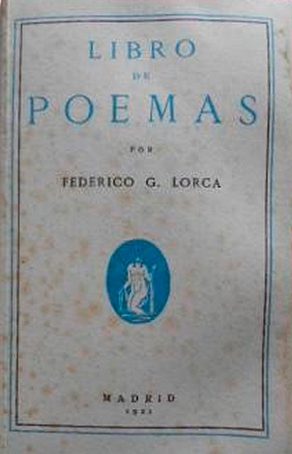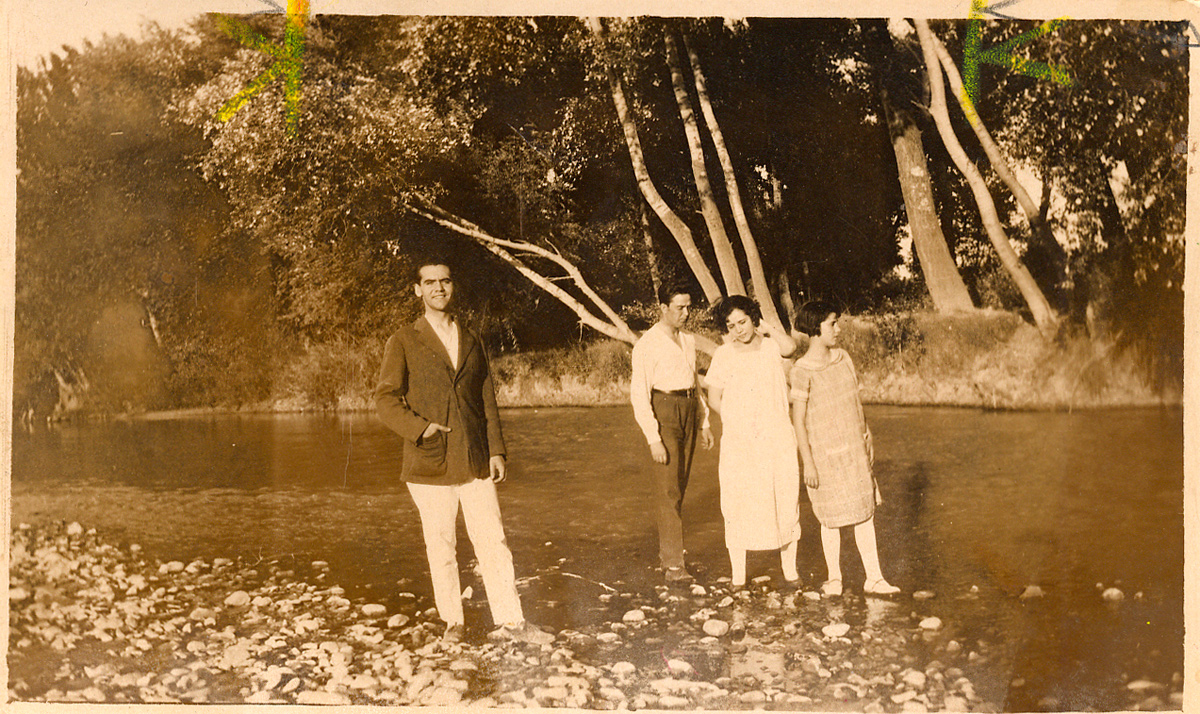
Book of Poems (Libro de poemas) is a collection of 67 poems written in adolescence or youth that deal with the loss of childhood paradise, about the crisis or disenchantment. The poetic subject dialogues lyrically with the landscape of his childhood and youth, manifesting a clear tension between that lost world and the awareness of a crisis.
In this recreation of his happy paradise, of innocence or “natural” truth appears the environment of the Vega of Granada, its elements (animals, plants, river, fountain…, which often function as symbols), the popular folklore, the songs or children’s games, people’s religiousness…
They are poems that denote in many cases the influence of modernism (Machado, Juan Ramón or Rueda) and in others, the neo-popularist tendency, or they even surprise us with some avant-garde image (”The moon has bought him / Paintings of Death”, he says in the poem The Moon and Death).
Although the poems were written between 1918 and 1920, they were not published until 1921. He entrusted the poems to Gabriel García Maroto for their publication. It seems that Maroto almost had to take the manuscript away from him, because he kept doubting its publication. The publisher typed the manuscript and asked Federico to correct and date the poems. The book appeared riddled with typos; maybe he didn’t check the proofs.
The volume had 229 pages and 67 poems. It contained a few words of justification stating the poet’s dissatisfaction with the collection, as well as the sentimental value these texts had for him. According to Mora Guarnido the introduction was actually written by García Maroto in view of the author’s delay in delivering the promised original.
Mora Guarnido himself announced the imminent appearance of the book on July 1, 1921, in the Noticiero Granadino. The review did not have much transcendence outside Granada. On July 30 in El Sol published in Madrid, the music critic Adolfo Salazar, wrote another review in which he clarified that this was a work of “transition”. He highlights the 1920 compositions which are seen to have a “modern profile”. Also Cipriano Rivas Cherif and Guillermo de Torre wrote reviews of the book, highlighting its pantheism. Torre reproached him for his excessive sentimentalism, but praised his capacity for metaphor.
The edition, like before Impresiones y paisajes (Impressions and Landscapes), his literary debut, was paid for by his father, Mr.Federico García Rodríguez (it cost him about 1,700 pesetas).
When this book is published, in 1921, the author -as he says in the prolog- is already dissatisfied with the collection of poems, but he says that it will serve to preserve all those childhood memories that appear in them…
The poems, which are not in chronological order, are instead dated and, in many cases, located in a place: Fuente Vaqueros, the Vega de Zujaira, Granada and Madrid. Lorca was born, as we know, in Fuente Vaqueros, on June 5, 1898, on Trinidad Street. Later on his parents moved to Calle de la Iglesia. Between 1906 and 1907 they moved to Asquerosa (today Valderrubio), in the Vega de Zujaira. Throughout his youth, he spent winters in Granada (first in the house on Acera del Darro and then in an apartment on the Acera del Casino) and summers in the countryside. This valley is also where the Cortijo de Daimuz (Daimuz Farmhouse) is located. Federico’s father had bought dry land next to the river Cubillas and the last irrigation ditch of the valley and converted them, through an irrigation plan, into the farmhouse of Daimuz Bajo (later they sold it for a fortune and buy land in Valderrubio).

From the indications given by the poet himself after the title (date and place), we can relate the elements that appear in these poems to his landscape or his experiences in Granada and its Valley:
• We know (from his sister Isabel, who tells us so in her book Recuerdos míos (My Memories)) that many of the children’s games or folk songs of the Valley appear in these poems: Balada Triste (Sad ballad), Santiago, Balada Interior (Interior ballad) “Frío, frío [“Cold, cold] / como el agua del río” [like the river water”]), Balada de la placeta (Little Square Ballad), Balada de un día de julio (Ballad of a Day in July).
• The references to the river or the fountain make us think of the river Cubillas (tributary of the Genil) or Fountain of la Teja or La Carrura: como el agua del río” (“My Heart Rests Beside the Cool Fountain”) (poem Sueño (Dream), 1919).
• The harvest season is reflected in some poems, such as Espigas (Ears of Corn). Federico’s family moved to the countryside precisely after the Corpus Christi festivities in Granada for the wheat harvest.
– We see the literary use of religious elements or popular imagery such as Satan, Lucifer or the goat that appears in several of these poems: CoRazón nuevo (New Heart), Prólogo (Prolog), Mar (Sea), Sueño (Dream), (El macho cabrío (The Billy Goat) …. And of references to life in Granada and, above all, in the countryside: bells, white snow (Elegy), countryside, poplars, black poplars, river, fountain, spring, frogs.…
Cantan los niños
[the children sing]
en la noche quieta;
[in the quiet night]
¡arroyo claro,
[clear stream!]
fuente serena!
[serene spring/fountain!]
LOS NIÑOS
[THE CHILDREN]
¿Qué tiene tu divino
[what has your divine]
corazón en fiesta?
[heart so festive?]
YO
[ME]
Un doblar de campanas
[a doublet/pair of bells]
perdidas en la niebla.
[lost in the fog/mist.]
LOS NIÑOS
[THE CHILDREN]
Ya nos dejas cantando
[you/it already leaves/has us singing]
en la plazuela.
[in the little square]
¡Arroyo claro,
[clear stream!]
fuente serena!
[serene spring!]
¿Qué tienes en tus manos
[what do you have in your hands]
de primavera?
[of springtime?]
YO
[ME]
Una rosa de sangre
[a rose of blood / a blood rose]
y una azucena.
[and a lily.]
LOS NIÑOS
[THE CHILDREN]
Mójalas en el agua
[wet them in the water]
de la canción añeja.
[of the aged/old song.]
¡Arroyo claro,
[clear stream!]
fuente serena!
[serene spring!]
¿Qué sientes en tu boca
[what do you feel in your mouth]
roja y sedienta?
[red and thirsty?]
YO
[ME]
El sabor de los huesos
[the flavor of the bones]
de mi gran calavera.
[of my great skull.]
LOS NIÑOS
[THE CHILDREN]
Bebe el agua tranquila
[drink the tranquil water]
de la canción añeja.
[of the aged song.]
¡Arroyo claro,
[clear stream!]
fuente serena!
[serene spring!]
¿Por qué te vas tan lejos
[why do you go so far]
de la plazuela?
[from the little plaza?]
YO
[ME]
¡Voy en busca de magos
[I go in search of magicians]
y de princesas!
[and of princesses!]
LOS NIÑOS
[THE CHILDREN]
¿Quién te enseñó el camino
[who showed you the way/path]
de los poetas?
[of the poets?]
YO
[ME]
La fuente y el arroyo
[the spring and the stream]
de la canción añeja.
[of the aged/old song.]
LOS NIÑOS
[THE CHILDREN]
¿Te vas lejos, muy lejos
[are you going far, very far]
del mar y de la tierra?
[from the sea and from the earth?]
YO
[ME]
Se ha llenado de luces
[it has filled with lights]
mi corazón de seda,
[my heart of silk,]
de campanas perdidas,
[of lost bells]
de lirios y de abejas,
[of lilies and bees,]
y yo me iré muy lejos,
[and I will go very far,]
más allá de esas sierras,
[further than those mountains,]
más allá de los mares,
[further than the seas,]
cerca de las estrellas,
[close to the stars,]
para pedirle a Cristo
[to ask Christ]
Señor que me devuelva
[please God give me back]
mi alma antigua de niño,
[my ancient childhood heart,]
madura de leyendas,
[ripe with legends]
con el gorro de plumas
[with a plumed/feathered hat]
y el sable de madera.
[and the wooden saber.]
LOS NIÑOS
[THE CHILDREN]
Ya nos dejas cantando
[already you/it leaves/has us singing]
en la plazuela,
[in the little square,]
¡arroyo claro,
[clear stream!]
fuente serena!
[serene spring!]
Las pupilas enormes
[the enormous (eye)pupils]
de las frondas resecas
[of the dried fronds]
heridas por el viento,
[wounded by the wind,]
lloran las hojas muertas.
[cry/crying the dead leaves.]